Science News Bacteria And Gardening
Soil is easy to ignore. We might notice it when gardening or playing outdoors. But even when we forget about it, soil is always there, everywhere.
Most of what we see are mineral particles that we recognize as sand, silt or clay. There's also plenty of water and air. But soil also is alive. It contains countless fungi and microbes. They help recycle the dead by breaking down the remains of plants, animals and other organisms.

Educators and Parents, Sign Up for The Cheat Sheet
Weekly updates to help you use Science News for Students in the learning environment
Thank you for signing up!
There was a problem signing you up.
Scientists study these things every day. These specialized researchers get their hands dirty to learn more about the very important ways that soils help us. They think soil is so important that they named 2015 the International Year of Soils. Soil, they note, is not only essential for life but also plays a role in everything from flood control to climate change.
More than dirt
If you were to divide a soil sample into 20 parts, 9 parts would be made up of the stuff we think of as dirt: clay, silt and sand. These are inorganic particles, which means they come from non-living sources. A full half, or 10 parts, would be equally divided between air and water. The last part would be organic, made from dead and decaying organisms. The soil also would contain countless numbers of minuscule microbes, mostly fungi and bacteria.
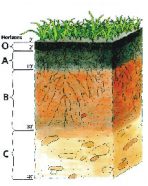
Those are the proportions in healthy soil. But the mix can vary. Soils compacted by heavy equipment may contain little air or water. As a result, these soils also will have fewer microbes. Drought dries out a soil, which also affects its microbial dwellers. Farming practices also can affect the composition of soil and its microbes.
And those microbes are important for several reasons. For one, they affect how much air and water is in the soil. How? These organisms create open areas — pockets — through which air and water can move. Microbes do this by clinging to clumps of soil. Soil scientists call these clumps aggregates (AG-gruh-guts). Bacteria and some fungi ooze "glue" that binds aggregates together. Other fungi practically stitch together soils with threadlike extensions called hyphae (HY-fee). Soils containing more aggregates have more pockets available for water and air. Plant roots can penetrate deeper into these soils. When those plants are crops, healthy soil helps put food on the table.
Feeding the crops that feed us
Soil microbes perform a range of jobs. Some break down dead plant and animal cells. Without those microbes, the dead stuff would pile up pretty fast. What's more, living plants and animals wouldn't last long. That's because dead organisms contain nutrients. When microbes recycle these organisms, they release those nutrients back into the soil. That nourishes plants and other soil-dwelling organisms. And those organisms, in turn, feed other critters.
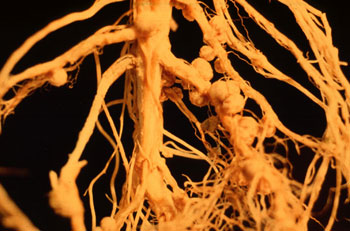
Some microbes provide nutrients to plants more directly. Of particular importance are microbes that live in the rhizosphere (RY-zo-sfeer). It's a special soil habitat that forms in the 5 millimeters (0.2 inch) of soil surrounding a plant's roots, notes Emma Tilston. She is a soil scientist at East Malling Research in Kent, England. Special communities of microbes develop in the rhizosphere. They help plants grow by providing them essential nutrients, such as nitrogen and phosphorus.
Some plants are particularly dependent on those microbes. Legumes are a group that includes peas, beans and clovers. These plants develop a special relationship with bacteria known as rhizobia (Rye-ZOH-bee-uh). These germs "fix" nitrogen. That means they take nitrogen from the air and turn it into ammonium. (Ammonium is chemically similar to ammonia but contains an extra hydrogen atom.) Rhizobia are useful because plants need nitrogen but can't pluck it directly from the air. The nitrogen they use has to be in a certain form, such as ammonium.
Plants and the nitrogen-fixers help each other. The plants' roots develop warty nodules to house the rhizobia. (If you uproot one of these plants, the nodules are often easy to spot.) These nodules are important because the bacteria can't fix nitrogen if there is oxygen around. The nodules provide an oxygen-free home for the bacteria to do their thing. The plants also provide the bacteria with carbon, which the bacteria use as food.
Such a mutually beneficial relationship is called a symbiosis (Sim-bee-OH-siss). Farmers and gardeners can take advantage of this by planting peas and beans close to other types of crops. Doing so provides nitrogen to plants that do not house rhizobia bacteria.
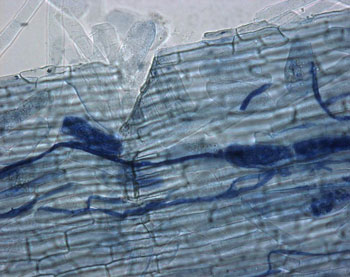
Some fungi also maintain symbiotic relationships with plants. These fungi have two different types of those threadlike hyphae. One type grows inside the plant's roots. The other grows from those roots into the soil. Hyphae exploring the soil absorb water and nutrients, especially phosphorus, says Tilston. They then carry these nutrients back to the plant's root. Then the hyphae growing inside root cells get to work. They exchange the water and phosphorus for sugars from the plant. All benefit from these activities, including the soil.
Another group of microbes helps to prevent plant diseases. Plants can be harmed when "bad" microbes, called pathogens, attack their roots and cut off their water supply. But good microbes in the rhizosphere can protect plants from those pathogens. They do this in two ways. They can directly kill the pathogen and turn it into a nutrient soup. Those microbes also can encourage the plant to protect itself by growing thicker cell walls.
Clearly, Tilston points out, many microbes boost plant health. But healthy microbes in turn require healthy soils. Certain farming practices help build and maintain healthy soils. That can help protect those mighty, but minuscule, organisms — and yield better crops. So healthy soils are critical to feeding the world's growing population.
Stopping the flood
In addition to helping crops, healthy soils can directly benefit people. Soils with lots of those air and water pockets are better at absorbing rainfall. This permits more water to soak into the ground during storms. That means there's less runoff. And that can prevent damaging floods.
One reason cities flood easily is because they have many impermeable (Im-PER-mee-uh-bull) surfaces, explains Bill Shuster. As a hydrologist with the Environmental Protection Agency (EPA) in Cincinnati, Ohio, Shuster studies water. Impermeable surfaces don't allow water to move through them. Roofs, roads, sidewalks and most parking lots are impermeable. The rain that falls on these structures can't soak into the ground. Instead, that water flows downhill and across the land, usually into a storm sewer.
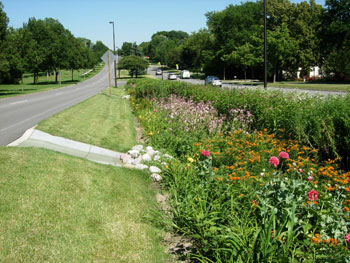
When a sewer system receives more water than it can handle, it backs up. Sewer overflow isn't pretty, Shuster says. Many cities have a combined sewer system. That means sewage from our toilets shares part of the drainage system for rainwater. Normally, those two don't mix. But when sewers overflow, sewage — and all the germs that go along with it — can wind up on city streets or in streams, rivers and lakes.
The best way to prevent such overflow problems, says Shuster, is to have plenty of places that soak up rain. How well those places do so depends on the types and quality of soil. So Shuster and a team of EPA researchers study the soils in U.S. cities. They drill into the ground to remove tube-shaped "cores." These can be as deep as 5 meters (16 feet). Cores from undisturbed areas can provide data on the condition of soils that formed as far back as 10,000 years ago, Shuster says.
There's plenty to learn from these cores. The color of the soil layers, for example, can tell scientists whether the area has soaked up water in the past. If so, it might be a good spot for the city to install a rain garden or a type of landscaping called a bioswale. Typically, these features are planted with grasses and other water-tolerant plants. Water that runs across the land during storms collects in these areas. Their greenery traps the water, letting it soak into the ground. That reduces the amount of water that ends up in sewers.
Some core samples contain soils that don't absorb water very well. Shuster recommends that cities avoid trying to funnel water into the areas from which these cores were taken.
You can help the ground soak up rain around your home, too. If your yard has good drainage, you can install a rain garden. Or you can use rain barrels to collect rainfall. These containers capture water from a building's downspouts. Once saved, gardeners can hydrate their plants with this water during dry spells. And by slowing the rate at which water reaches the ground, people can help limit runoff.
From the ground to the atmosphere
Reducing runoff might have the added benefit of combating climate change. When excess rain rushes across bare soil, it picks up and carries off some of the soil's organic and inorganic material. That material travels downstream in a process called erosion. This diminishes soils. And poor soil quality can affect Earth's climate.
Explainer: Global warming and the greenhouse effect
Of all soil layers, topsoil is the most susceptible to erosion, explains Eric Brevik. He is a soil scientist at Dickinson State University in North Dakota. Topsoil is chockablock with organic matter — including those beneficial microbes. But organic matter weighs less than inorganic matter. So it's much easier for water to wash away topsoil during heavy rains. (You can see this if you put soil in a jar, add water and shake. After four hours, the inorganic particles will have settled to the bottom. But the organic particles still will float on the surface.)
Without those microbes, what's left of the soil can't support plant life very well. Using energy from the sun, plants take carbon dioxide from the air and combine it with water to make sugar. This process is called photosynthesis. And it's one way that plants help to remove carbon dioxide from the air. That's good for the planet, because that carbon dioxide has been accumulating in Earth's atmosphere. As a greenhouse gas, it traps the sun's heat, much as the windows in a greenhouse do. This carbon-dioxide buildup is behind a worrisome global warming.
By supporting plant growth, healthy soils can play a role in combating warming and other effects of climate change, notes Brevik. And here's how: As plants grow, they store carbon in their tissues. When they die, that carbon becomes part of the organic matter in the soil. Soil microbes break down some of that matter, releasing carbon dioxide into the air. As long as more organic matter is added than is broken down, the soil becomes a carbon "sink." That means it collects carbon, storing it where it can't affect climate.
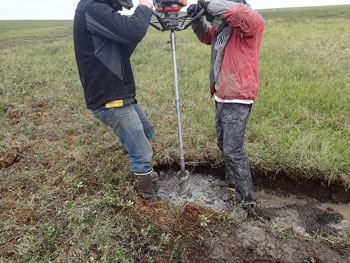
But warmer temperatures — which Earth is now experiencing — speed up the rate at which dead plants rot. And the activity of soil microbes "doubles for every 10-degree Celsius [18-degree Fahrenheit] increase in temperature," explains Brevik. As temperatures rise, soils may store less carbon. That can slow soil's role as a carbon sink.
What's more, speeding up rot can further boost climate change. As plants break down, they release carbon dioxide and methane, both greenhouse gases. If soil microbes break down organic matter faster than more is added, soil becomes a source of greenhouse gases. (So it adds more of the greenhouse gases instead of storing them away.)
Scientists are particularly concerned about the world's frozen soils, says Brevik. These soils have locked away carbon for thousands of years. As these soils begin to thaw, microbes can start breaking down the organic matter in those soils. And that could unlock a huge store of those greenhouse gases.
It's in everyone's interest to maintain healthy soils — and the plant communities they support. What can you do? Planting bare patches of soil in your yard or neighborhood would be a good start, says Brevik. Adding grass seed or creating a garden will cover the soil and help prevent erosion. And as those plants grow and drop leaves, they will also add organic matter, improving the soils on which we all depend.
Power Words
(for more about Power Words, click here )
aggregate The term scientists use to describe the clumps of organic and inorganic matter that make up soil.
ammonia A colorless gas with a nasty smell. Ammonia is a compound made from the elements nitrogen and hydrogen. It is used to make food and applied to farm fields as a fertilizer. Secreted by the kidneys, ammonia gives urine its characteristic odor. The chemical also occurs in the atmosphere and throughout the universe.
bacterium ( plural bacteria) A single-celled organism. These dwell nearly everywhere on Earth, from the bottom of the sea to inside animals.
bioswale A channel full of growing plants or mulch that is used to help soak up rainwater as it travels downhill. It is often used along streets or parking lots to reduce storm-water runoff.
carbon dioxide A colorless, odorless gas produced by all animals when the oxygen they inhale reacts with the carbon-rich foods that they've eaten. Carbon dioxide also is released when organic matter (including fossil fuels like oil or gas) is burned. Carbon dioxide acts as a greenhouse gas, trapping heat in Earth's atmosphere. Plants convert carbon dioxide into oxygen during photosynthesis, the process they use to make their own food. Its chemical symbol is CO2.
clay Fine-grained particles of soil that stick together and can be molded when wet. When fired under intense heat, clay can become hard and brittle. That's why it's used to fashion pottery and bricks.
climate The weather conditions prevailing in an area in general or over a long period.
climate change Long-term, significant change in the climate of Earth. It can happen naturally or in response to human activities, including the burning of fossil fuels and clearing of forests.
core In geology, Earth's innermost layer. Or, a long, tube-like sample drilled down into ice, soil or rock. Cores allow scientists to examine layers of sediment, dissolved chemicals, rock and fossils to see how the environment at one location changed through hundreds to thousands of years or more.
decay The process (also called "rotting") by which a dead plant or animal gradually breaks down as it is consumed by bacteria and other microbes.
drought An extended period of abnormally low rainfall; a shortage of water resulting from this.
Environmental Protection Agency(or EPA) An agency of the federal government charged with helping create a cleaner, safer and healthier environment in the United States. Created on Dec. 2, 1970, it reviews data on the possible toxicity of new chemicals (other than food or drugs, which are regulated by other agencies) before they are approved for sale and use. Where such chemicals may be toxic, it sets rules on how much may be used and where it may be used. It also sets limits on the release of pollution into the air, water or soil.
erosion The process that removes rock and soil from one spot on Earth's surface and then deposits the material elsewhere. Erosion can be exceptionally fast or exceedingly slow. Causes of erosion include wind, water (including rainfall and floods), the scouring action of glaciers, and the repeated cycles of freezing and thawing that often occur in some areas of the world.
fix To convert nitrogen in the air into a compound usable by plants.
fungus (plural: fungi) One of a group of single- or multiple-celled organisms that reproduce via spores and feed on living or decaying organic matter. Examples include mold, yeasts and mushrooms.
global warming The gradual increase in the overall temperature of Earth's atmosphere due to the greenhouse effect. This effect is caused by increased levels of carbon dioxide, chlorofluorocarbons and other gases in the air, many of them released by human activity.
greenhouse effect The warming of Earth's atmosphere due to the buildup of heat-trapping gases, such as carbon dioxide and methane. Scientists refer to these pollutants as greenhouse gases. The greenhouse effect also can occur in smaller environments. For instance, when cars are left in the sun, the incoming sunlight turns to heat, becomes trapped inside and quickly can make the indoor temperature a health risk.
greenhouse gas A gas that contributes to the greenhouse effect by absorbing heat. Carbon dioxide is one example of a greenhouse gas.
hydrology The study of water. A scientist who studies hydrology is a hydrologist.
hypha (plural: hyphae) A tubular, threadlike structure that makes up part of many fungi.
impermeable An adjective for something that will not let a liquid flow through it.
inorganic An adjective that indicates something that does not contain carbon from living organisms.
legumes Beans, peas, lentils and other plants with seeds that grow in pods. Legumes are important crops. These plants also host bacteria that help enrich the soil with nitrogen, an important nutrient.
methane A hydrocarbon with the chemical formula CH4 (meaning there are four hydrogen atoms bound to one carbon atom). It's a natural constituent of what's known as natural gas. It's also emitted by decomposing plant material in wetlands and is belched out by cows and other ruminant livestock. From a climate perspective, methane is 20 times more potent than carbon dioxide is in trapping heat in Earth's atmosphere, making it a very important greenhouse gas.
microbe Short formicroorganism. A living thing that is too small to see with the unaided eye, including bacteria, some fungi and many other organisms such as amoebas. Most consist of a single cell.
nitrogen A colorless, odorless and nonreactive gaseous element that forms about 78 percent of Earth's atmosphere. Its scientific symbol is N. Nitrogen is released in the form of nitrogen oxides as fossil fuels burn.
nodule A small roundish bump or growth.
nutrients Vitamins, minerals, fats, carbohydrates and proteins needed by organisms to live, and which are extracted through the diet.
organic (in chemistry) An adjective that indicates something is carbon-containing; a term that relates to the chemicals that make up living organisms.
organism Any living thing, from elephants and plants to bacteria and other types of single-celled life.
oxygen A gas that makes up about 21 percent of the atmosphere. All animals and many microorganisms need oxygen to fuel their metabolism.
particle A minute amount of something.
pathogen An organism that causes disease.
permafrost Soil that remains frozen for at least two consecutive years. Such conditions typically occur in polar climates, where average annual temperatures remain close to or below freezing.
permeable Having pores or openings that permit liquids or gases to pass through. Sometimes materials can be permeable for one particular type of liquid or gas (water, for example) but block others (such as oil). The opposite of permeable is impermeable.
phosphorus A highly reactive, nonmetallic element occurring naturally in phosphates. Its scientific symbol is P.
photosynthesis (verb: photosynthesize) The process by which green plants and some other organisms use sunlight to produce foods from carbon dioxide and water.
rain barrel A container that catches rain from downspouts. Rain barrels capture and store excess rain water. Later, that water can be used to promote the growth of plants.
rain garden A shallow basin planted with grasses and other plants that can tolerate both dry periods and times when their roots are submerged in water. Rain gardens help to slow the movement of water, so that it can soak into the ground, instead of running off into storm sewers.
recycle To find new uses for something — or parts of something — that might otherwise by discarded, or treated as waste.
rhizosphere The 5 millimeter (0.2 inch) space surrounding plant roots. This region contains many microorganisms that can help plants exchange water and nutrients with the surrounding soil.
runoff The water that runs off of land into rivers, lakes and the seas. As that water travels over land, it picks up bits of soil and chemicals that it will later deposit as pollutants in the water.
sewer A system of water pipes, usually running underground, to move sewage (primarily urine and feces) and stormwater for collection — and often treatment — elsewhere.
silt Very fine mineral particles or grains present in soil. They can be made of sand or other materials. When materials of this size make up most of the particles in soil, the composite is referred to as clay. Silt is formed by the erosion of rocks, and then usually deposited elsewhere by wind, water or glaciers.
symbiosis A relationship between two species that live in close contact.
Word Find(click here to enlarge for printing)
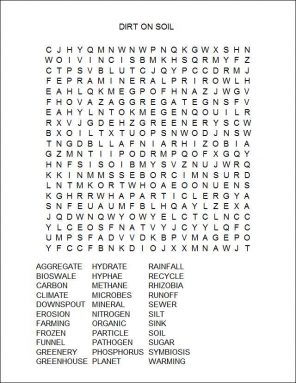
Science News Bacteria And Gardening
Source: https://www.sciencenewsforstudents.org/article/dirt-soil
Posted by: mcelroywitaysen.blogspot.com

0 Response to "Science News Bacteria And Gardening"
Post a Comment